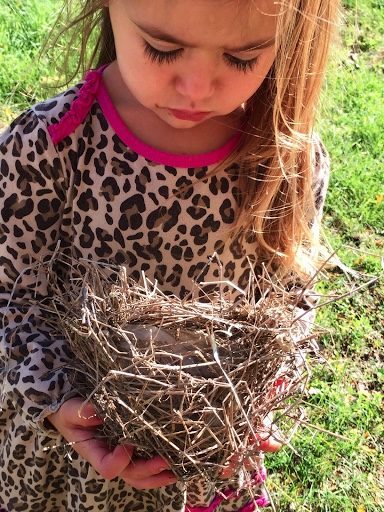
Investigating Nests
"I found an empty nest! Can we keep it?" Owen's joyful discovery captures everyone's attention.
Three-year-old Daniela comes running. "Are there eggs?" she asks her older and wiser five-year-old friend. "Can I see it?”
"No eggs, just an old nest," Owen tells Daniela before looking up at me imploringly. "Can we please keep it?"
He handles the nest gingerly before realizing that it is sturdier than it looks. After studying the nest for a few minutes, he very gently hands it over to the others.
I realize that the Migratory Bird Treaty Act of 1918 makes collecting or possessing bird nests illegal in certain areas, but I'm pretty sure that we are in the clear on this nest.
To be honest, we have a collection of nests. We love to study the materials used to build each nest and the engineering methods used by different local bird species.

I watch Daniela silently investigating and collecting data as she turns the nest in one direction and then another. You can almost see the wheels turning in her mind.
"I think the bird used some litter to build this nest," she says with a giggle. “I see a straw and some string and a gum wrapper. And there are like a million sticks in here!"
"The bird added string—and look at this piece of wire she wove in," Maya observes. “How can it be so light but so strong that it held the mother bird and her eggs? Remember how windy it was last night? This nest didn’t even come apart or fall out of the tree.”
These moments of hands-on exploration enable the children to engage in tactile learning as they explore the textures of the different nest materials and deepen their understanding of how these materials are used to build a strong and sturdy nest. This is how we set our curriculum for the day: by following the interests of the children.
“I wish I could see how the bird made this nest without any tape or glue," Daniela says, thinking out loud. "How do birds make their nests so strong with just their beaks and feet?”
“I watched a show with my family about this,” Michaela pipes in. “Birds can use their beaks to pull string or strips of paper or plastic over and under the twigs and grass like they are weaving a potholder. They can even tie knots with their beaks! The nests take a really long time to make, so sometimes the birds come back and use the same nest every year."
"When we get back to school," I say, "I will show you a nest that looks like this one in a book from our classroom library. I think we can figure out which bird made this nest.”

The children in our early learning program often investigate nests to try to figure out what kind of bird built each nest and how many eggs might have been laid in these cozy homes crafted from sticks, grass, leaves, string, mud, and other found objects.
We even bring out our magnifying glasses and deconstruct a nest or two. Deconstructing a bird's nest is a rich educational experience that blends science, engineering and appreciation of the natural world. It's a perfect opportunity for preschoolers to learn through exploration and discovery.
When children examine how a bird's nest is constructed, they are introduced to basic principles of engineering and architecture through nature’s own processes.
Birds build sturdy and functional nests that are tailored to their specific needs. Each bird builds a different type of nest that provides protection, insulation and room to raise the baby birds.
By investigating different types of bird nests, children can learn about adapting designs to suit different purposes—a fundamental aspect of engineering.

When we return to the classroom, we select a few books about bird nests to read before naptime.
Here are a few of our favorite bird and nest books:
- A Nest is Noisy by Dianna Hutts Aston
- An Egg is Quiet by Dianna Hutts Aston
- Bird Builds a Nest: A First Science Storybook by Martin Jenkins
- Birds and Their Nests by Linda Tagliaferro
- Little Swan by Jonathan London
- The Beak Book by Robin Page
- Whose Nest? by Victoria Cochrane
Looking for more engineering books and activities? Check out our Engineering Explorers Resources section and our Build a Nest lesson plan!